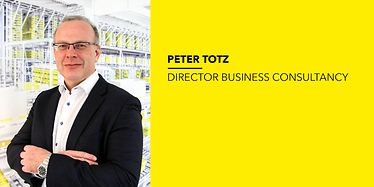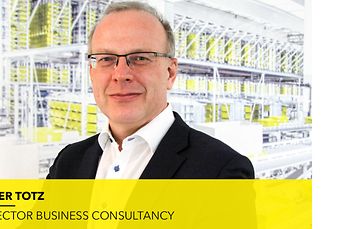

Ines and Max
Ines and Max are sitting in the warehouse control center monitoring the operating states of the material flow systems on the screens that surround them. The visualization does not show any incidents, everything appears to be running smoothly. In fact, it looks like today is going to be a pretty boring day. Besides compiling tours and monitoring departure times, there are no important orders announced. As usual, tours are being put together according to the areas that need to be supplied, and e-commerce deliveries are handled continuously by the contracted service providers at their allocated docks.
Suddenly, the system reports a fault on the main line of the pallet conveyor system leading from the automated warehouse to repacking into the container area and from there into the picking buffer. Max sends Kurt, the technician on duty, to take a look at the incident and is now waiting to hear back from him. Taking a look back onto the screens, they notice that the time for daily order completion has shifted into the red zone. The system sets off the alarm because the time of order completion originally set to today, 9:30 p.m., has been pushed back to 1:00 a.m. the next morning. Ines tries to find out what caused that delay and notices that the backlog of orders has suddenly jumped up considerably. An advertising campaign that the warehouse was not informed about has led to a number of customers placing urgent orders for next-day delivery.
Shortly after this, Kurt gets in touch and asks for help. One of the pallets has got a loose bottom board, which is now stuck in the system. Unfortunately, the pallet’s load was not secured properly, so some of the goods slipped off the pallet and are now blocking the driving chain. Kurt wants to move the goods onto another pallet since the conveying section will remain blocked until this has been taken care of. Kurt knows from experience that it takes approximately 45min to solve this kind of incident. If there is no replenishment, the processing of customer orders will be delayed even further.
Impact and challenges
Ines and Max are facing the challenge of having to completely readjust a system with complex interdependencies quickly in order to minimize the negative impact.
Some warehouses are extremely large and complex. For example, one of our customers operates a warehouse that spans 350,000 m2 across five connected halls on one site, with many differently equipped, automated warehouse areas and a total of 28 km of interconnected conveying systems. In a warehouse like this, it is becoming more and more difficult to keep an overview of the system and coordinate all system sections in line with changing requirements.
Without digital assistants that alert users to potential complications and help to resolve them, operating an intralogistics system of this scale is a Sisyphean task. In some cases, tiny details can have a huge impact at the points where problems are least expected. This even has a scientific basis in the form of non-linear dynamics and chaos theory, which refers to this phenomenon as the butterfly effect.
Read how the story will continue and how Ines and Max are facing the situation in the next blog post of SSI SCHAEFER.

Peter Totz works as Director Business Consultancy at SSI SCHAEFER.
His career began as a project engineer, data analyst and simulation specialist in Graz. With intermediate steps in production planning and as a logistics consultant, he worked as a senior consultant and project manager for many years. Later, he was responsible for business development in Latin America before taking over the lead of the globally active Business Consultancy Group.